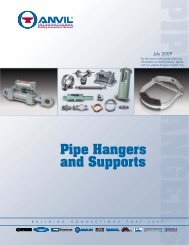Nibco Plastics Catalog - Paramount Supply
Nibco Plastics Catalog - Paramount Supply
Nibco Plastics Catalog - Paramount Supply
You also want an ePaper? Increase the reach of your titles
YUMPU automatically turns print PDFs into web optimized ePapers that Google loves.
92<br />
AHEAD OF THE FLOW ®<br />
Expansion and Contraction of Plastic Pipe (Continued)<br />
Where:<br />
ΔL = Dimensional change due to thermal expansion<br />
or contraction (in.)<br />
Y = Expansion coefficient (in/10°F/100ft) (See Table<br />
on previous page)<br />
(T1-T2) = Temperature differential between the installation<br />
temperature and the maximum and minimum<br />
system temperature, which ever provides the<br />
greatest differential (°F)<br />
L = Length of pipe run between changes in direction<br />
(ft)<br />
Example 1:<br />
How much expansion can be expected in a 200 foot straight run<br />
of nominal size 3 PVC Pipe that will be installed at 75°F when<br />
the piping system will be operated at a maximum of 120°F and<br />
a minimum of 40°?<br />
ΔL = 0.360(120 - 75) x 200<br />
10 100<br />
ΔL = .360 x 4.5 x 2.0 = 3.24 inches<br />
Stresses and forces that result from thermal expansion and<br />
contraction can be reduced or eliminated by providing for<br />
flexibility in the piping system through frequent changes in<br />
direction or introduction of loops as graphically depicted in the<br />
figures below.<br />
Normally, piping systems are designed with sufficient directional<br />
changes which provide inherent flexibility to compensate<br />
for expansion and contraction. However, when this is not the<br />
case or when there is reasonable doubt as to the adequate<br />
flexibility of the system, expansion loops or expansion joints<br />
should be designed into the system. If an expansion loop<br />
(which is fabricated with 90° elbows and straight pipe as<br />
depicted in Fig. 1) is to be used, the leg length (R) should be<br />
determined by using the following formula to insure that it is<br />
of sufficient length to absorb expansion and contraction movement<br />
without damage.<br />
R = 1.44 √DΔL<br />
Where:<br />
R = Expansion loop leg length (ft)<br />
D = Nominal outside diameter of pipe (in)<br />
ΔL = Dimensional change due to thermal expansion or<br />
contraction (in)<br />
NIBCO INC. WORLD HEADQUARTERS 1516 MIDDLEBURY ST. ELKHART, IN 46516-4740 USA PH: 1.800.234.0227<br />
TECH SERVICES PH: 1.888.446.4226 FAX: 1.888.336.4226 INTERNATIONAL OFFICE PH: +1.574.295.3327 FAX: +1.574.295.3455<br />
www.nibco.com<br />
www.nibco.com<br />
Revised 9/10/2009<br />
Example 2:<br />
How long should the expansion loop legs be in order to compensate<br />
for the expansion in Example 1?<br />
R = 1.44 √DΔL<br />
Flexibility, through the introduction of flexural off-sets, must<br />
be inserted into a piping system design in situations where<br />
straight runs of pipe are long or the ends of a straight run are<br />
restricted from movement and also in situations where the system<br />
is restrained. Several examples of methods for inserting<br />
flexibility in these situations are graphically presented below.<br />
In each case, rigid supports or restraints should not be placed<br />
within the leg length of an expansion loop, off-set, or bend.<br />
Fig. 1 Fig. 3<br />
Fig. 3 Fig. 4



